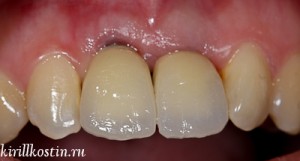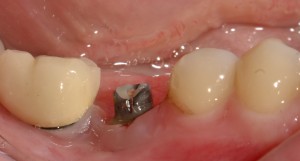Tooth implant rejection

Implant engraftment is a rather complex and multi-stage process.
After implantation into the bone of the jaw, it undergoes a number of changes.
The success of the engraftment of a structure is largely determined by the structure of its surface.
Osteointegration of the implant, having a more porous surface, which improves its stability in the bone, is faster.
Tooth implant rejection is one of the most serious complications of implantation.
According to statistics, rejection occurs in 2% of cases. Rejection can occur at any moment, both instantly and after some time.
In turn, manufacturers of implants, striving to make such structures, the percentage of rejection which would be reduced to a minimum. Some serious manufacturers claim that the percentage of rejection of their implants ranges from 0, 2 to - 0.3%, due to the features of the shape and coating.
Reasons for rejection
Causes of implant rejection may be related to:
- Poor work of the surgeon - implantologist.
- Failure by the patient to recommend a doctor after surgery.
- The individual characteristics of the body.
One of the reasons for violation of the engraftment of the structure may be poorly performed work of the surgeon - implantologist.
In this case, the cause of the violation may be:
- Wrong choice of implant.
- The lack of professionalism of a doctor.
- Inadequate preoperative preparation.
- Failure to comply with the rules of asepsis and antiseptics.
- Lack of sufficient bone tissue.
- Implantation with poor bone quality.
- Injury or overheating of the bone during implant placement.
As a rule, if non-survival of the structure occurs for the above reasons, then its rejection is observed in the first weeks - a month after implantation.
Individual characteristics of the body that can cause implant rejection:

- Intolerance or high sensitivity of the body to a foreign body.
- Exacerbation of chronic diseases.
- Decreased immunity.
- Untreated teeth with foci of inflammation (cysts, granulomas) located next to the implant.
- Excessive load on the implant due to the insufficient number of implants installed.
- Reimplantitis
- Features of the anatomical structure of the jaw.
Rejection in this case can occur at various stages of implant engraftment.
Design rejection may occur due to patient failure to comply with the doctor's recommendations:

- Uncontrolled medication.
- Refusal to take antibacterial drugs.
- Violation of diet.
- A visit to the sauna or bath in the early postoperative period.
- Lack of hygienic care for the oral cavity and implants.
- The presence of bad habits.For example: smoking.
- Refusal to undergo preventive examinations at the dentist.
The rejection of the implant after a sufficiently long period after its installation (year, two or more) can occur in the following cases:
- Trauma to the jaw, which can provoke a displacement of the implant and cause inflammation of the bone tissue.
- A sharp decrease in immunity.
- Exacerbation of a chronic disease.
- Infection.
Symptoms
Implant rejection may be accompanied by the following symptoms:

- The presence of sharp pain in the area of the implanted structure.
- Bleeding at the site of implantation.
- In some cases, there is an increase in body temperature.
- Hyperemia, swelling of the gums around the implanted tooth root.
- Isolation of pus.
- The mobility of the structure.
If symptoms of implant rejection appear, consult your dentist immediately.
What to do
- If rejection of the implant has begun, then the most effective treatment is removal of the construct.
- After removal, a drug treatment is carried out aimed at restoring bone tissue and improving regenerative processes in it.
- The cause and treatment of the disease that caused the rejection of the implant is established.
- The restoration of immunity.
In some cases, it is possible to re-implant the implant in the jawbone.
The risk of failure of repeated implantation is high enough. In addition, it will require additional investments.
How to prevent rejection
- The choice of clinic should be based on the availability of documents for such services.
- The competence of medical personnel in the installation of dental implants.
- Sufficient experience in conducting such operations by an implantologist. The presence of diplomas, certificates that can confirm his qualifications in this area.
- A significant role is played by the presence of positive reviews from other patients about the activities of this doctor.